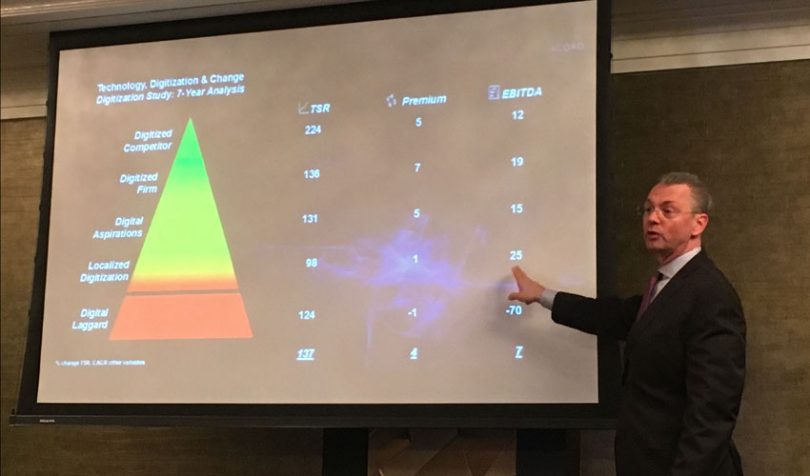Talking at the Blockchain for Insurance Summit, Bill Pieroni, ACORD’s CEO, spoke about the dangers of a wait-and-see approach with blockchain. The global standards-setting body for the insurance industry studied technology penetration for a hundred historical innovations including TV.
Surprisingly, they found that the rate of adoption is not much faster at roughly four percent a year. What’s changed is the lag between the initial invention and take off. In the past, it’s taken decades before the adoption takes off. However, no longer.
“You don’t have the time anymore. None of us do because by the time you figure out that it’s either dead (client-server technology) or taking off (IoT, blockchain, the rest of it). You don’t know. And you’ll never catch up because it’s not about throwing money at it,” said Pieroni.
He continued: “If people have been using technology, there’s a learning-by-doing that goes on. You’re not going to catch up with this. So the big change I think that’s occurred is this lag. It’s been taken up just as fast; you just don’t have time to wait and see.”
ACORD isn’t waiting. They’re a partner in the EY Maersk initiative that launched this month. Plus they’re involved in the Marsh proof of insurance project. Both the major blockchain industry alliances, B3i and Riskblock, are ACORD compliant.
How to identify a technology that will take off?
Through a study, ACORD identified several criteria. First, there’s the obligatory financial one: the timing, value, duration and riskiness of cash flows.
The technology needs to be capable of testing first. Insurers aren’t going to throw away decades of legacy investment. However, will the CFO believe positive test results are because of the technology as opposed to the economy or some other factor?
Any new technology needs to be compatible or capable of being integrated with legacy systems. Plus there needs to be some degree of homogeneity, some standard features, rather than every implementation being entirely different.
A tricky one for some CEOs is coopetition. Pieroni gave an example of a CEO who was only willing to participate in a blockchain project if he could own it. The ACORD CEO compared this to owning the only telephone in the world. It only has value if everybody has it. The CEO eventually came around.
Pieroni said: “We all compete with each other, but if there’s not a level of cooperation and collaboration around these technologies, it can’t be hoarded by anybody. It won’t scale. It will die off.”
There need to be authoritative adopters. People need to point to big names so they can see there’s some substance to this new technology. But Pieroni acknowledged that even with all these attributes, luck matters.
Insurers are bad at change
ACORD looked at 1000 insurance change efforts and found that two-thirds failed.
Pieroni attributed this to the nature of insurers. The companies are built for stability and consistency. They use the past as a predictor with their legacy claims databases. By nature, people who work at insurers dislike risk and are conservative.
The organizations are full of negative feedback loops. If someone tries something new a typical response is: “We don’t do that here.”
What about the third that managed to implement change successfully? A lot address these cultural issues.
When looking at issues and opportunities, there must be a focus on positive aspects. “So if you think about blockchain. It can’t just be that it’s some existential threat. There’s a real opportunity here to learn and grow and have impact for our clients,” said Pieroni.
There’s the expected goals and objectives. However, just as important is measuring behavior based changes, addressing those cultural issues. There’s the need for the CEO and CFO to commit, but also you need respected evangelists.
Pieroni commented: “Sometimes there’s people that maybe don’t have the stripes on their shoulder or the title but really have the informal authority, the credibility to get the organization behind something. These guiding coalitions and who’s driving change in the organizations are incredibly powerful.”
Finally, a successful change program needs plans, accountability, and implications, both reward for success and censure for failure.
The blockchain challenges for insurers
The above culture issue is a big challenge. Another people aspect is the ability to build capacity and competency. Insurers have a hard time attracting top quality talent. Also, there’s tremendous competition for blockchain talent right now.
In the list of criteria for success for technologies, one was integration with existing systems. Changing business processes is a big ask.
Based on this experience with the EY Maersk project, Pieroni laid down the gauntlet: “To really get value out of this you have to change your business processes.”






